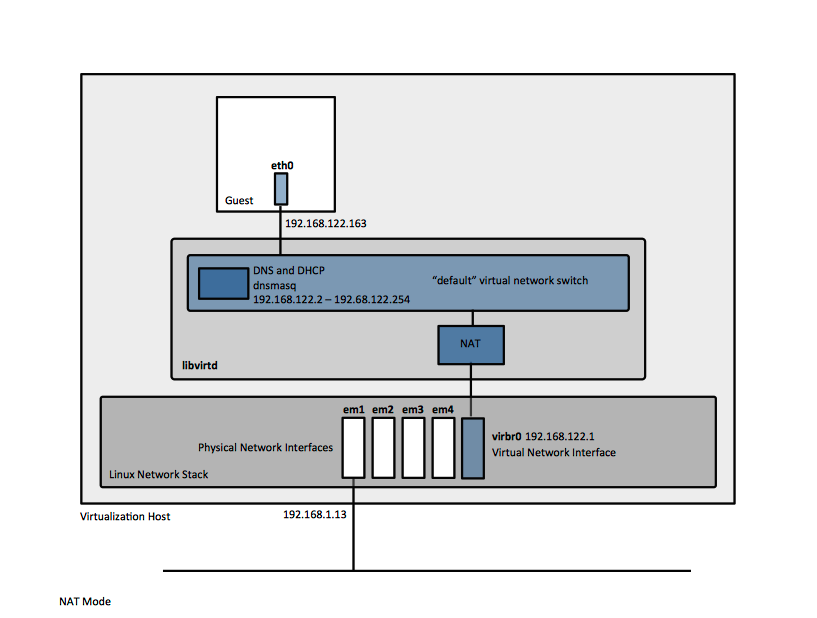KVM Virtual Networking Concepts: Difference between revisions
| Line 38: | Line 38: | ||
[[virsh net-edit|virsh net-edit default]] | [[virsh net-edit|virsh net-edit default]] | ||
=The Default Networking Configuration= | |||
By default, all guests on a virtualization host are connected to a virtual network switch running in [[#NAT_Mode|NAT mode]], in the same virtual network named "default". | |||
=Virtual Network Modes= | =Virtual Network Modes= | ||
Revision as of 18:40, 27 June 2017
External
Internal
Overview
This article discusses concepts related to virtual networking with libvirt.
Virtual Network Switch
libvirt implements virtual networking using a virtual network switch. A virtual network switch is a software component that runs on the virtualization host. The virtual machine guests connect to it and the network traffic to and from the guests passes through the virtual switch.
The virtual switch is started and managed by the libvirtd daemon and is represented as the virbr0 network interface:
# ip addr
...
7: virbr0: <BROADCAST,MULTICAST,UP,LOWER_UP> mtu 1500 qdisc noqueue state UP qlen 1000
link/ether 52:54:00:15:ef:87 brd ff:ff:ff:ff:ff:ff
inet 192.168.122.1/24 brd 192.168.122.255 scope global virbr0
valid_lft forever preferred_lft forever
...
The virtual network switch can operate in several modes, described below:
The DNS and DHCP Server
The virtual network switch uses a DNS and DHCP server. The DNS and DHCP are both served by a dnsmasq instance running on the virtualization host. Each virtual switch instance has its own dnsmasq instance. The configuration file is /var/lib/libvirt/dnsmasq/default.conf, but the configuration file should not be edited manually, but with
virsh net-edit default
The Default Networking Configuration
By default, all guests on a virtualization host are connected to a virtual network switch running in NAT mode, in the same virtual network named "default".
Virtual Network Modes
NAT Mode
The NAT mode is the default mode in which libvirt virtual network switch operates, without additional configuration.
The network address translation function is implemented as IP masquerading, using iptables rules. Connected guests will use the virtualization host physical machine IP address for communication with external networks (it is possible that the virtualization host IP address is unroutable as well, if the virtualization host sits in its own NAT domain). By default, without additional configuration, external hosts cannot initiate connections to the guest virtual machines.
Routed Mode
The libvirt virtual network switch can be configured to run in routed mode. In routed mode, the switch connects to the physical LAN the virtualization host is attached to, without the intermediation of a NAT module. All the guest virtual machines are in the same subnet, routed through the virtual switch. External traffic may reach the guest only if additional routing information is configured. The routed mode operates at Layer 3 of the OSI networking model.
Bridged Mode
Isolated Mode
If the libvirt virtual network switch is configured to run in isolated mode, the guest virtual machines can communicate with each other and with the virtualization host, but the traffic will not pass outside of the virtualization host, not can they receive external traffic. The guests still receive their addresses via DHCP from dnsmasq, and send their DNS queries to the same dnsmasq instance, which may resolve external names, but the resolved IP addresses won't be accessible.
Organizatorium
By default, all guests on a single host are connected to the same virtual network, named "default". Guests have default direct IP connectivity to all other guests and to the host. libvirt network filtering and guest operating system iptables rules apply. Guests have external outbound access via NAT, subject to the host system's firewall rules. From the point of view of the guest operating system, a virtual network connection is the same as a normal physical network connection.
The guest network interfaces can be set to one of the following modes:
- isolated mode - the network won't allow any traffic beyond the virtualization host.
- routed mode - the network will route traffic between the guest and external hosts without performing any NAT. This enables incoming connections but requires extra routing table entries for the systems on the external network.
- bridged mode - the guests are connected to a bridge device that is also connected directly to a physical ethernet device connected to the local ethernet. This makes the quests directly visible on the physical network, and thus enables incoming connections, but does not require any extra routing table entries.
